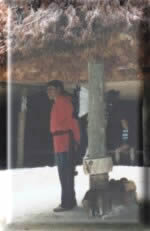Cherokee Indian Reservation
When the first white settlers reached the Great Smoky Mountains in the late 1700s they found themselves in the land of the Cherokee Indians. The tribe had permanent towns, cultivated farmland, and trails leading to all parts of their territory. By the 1830s the Cherokees had adopted the ways of the white man to the extent of developing a written language, printing their own newspaper, and utilizing the white man's agriculture and architecture. Nevertheless most of them were forcibly removed in the 1830s.
"Once an ally of the Cherokees, President Andrew Jackson authorized the Indian Removal Act of 1830, following the recommendation of President James Monroe in his final address to Congress in 1825. Jackson sanctioned an attitude that had persisted for many years among many white immigrants. Even Thomas Jefferson, who often cited the Great Law of Peace of the Iroquois Confederacy as the model for the U.S. Constitution, supported Indian Removal as early as 1802.
The displacement of native people was not wanting for eloquent opposition. Senators Daniel Webster and Henry Clay spoke out against removal. Reverend Samuel Worcester, missionary to the Cherokees, challenged Georgia's attempt to extinguish Indian title to land in the state, winning the case before the Supreme Court.
Worcester vs. Georgia, 1832, and Cherokee Nation vs. Georgia, 1831, are considered the two most influential decisions in Indian law. In effect, the opinions challenged the constitutionality of the Removal Act and the US. Government precedent for unapplied Indian-federal law was established by Jackson's defiant enforcement of the removal.
The U.S. Government used the Treaty of New Echota in 1835 to justify the removal. The treaty, signed by about 100 Cherokees and known as the Treaty Party, relinquished all lands east of the Mississippi River in exchange for land in Indian Territory and the promise of money, livestock, and various provisions and tools.
When the pro-removal Cherokee leaders signed that treaty, they also signed their own death warrants. The Cherokee National Council earlier had passed a law that called for the death penalty for anyone who agreed to give up tribal land. The signing and the removal led to bitter factionalism and the deaths of most of the Treaty Party leaders in Indian Territory.
Opposition to the removal was led by Chief John Ross, a mixed-blood of Scottish and one-eighth Cherokee descent. The Ross party and most Cherokees opposed the New Echota Treaty, but Georgia and the U.S. Government prevailed and used it as justification to force almost all of the 17,000 Cherokees from the southeastern homelands.
Under orders from President Jackson, the U.S. Army began enforcement of the Removal Act. Around 3,000 Cherokees were rounded up in the summer of 1838 and loaded onto boats that traveled the Tennessee, Ohio, Mississippi, and Arkansas Rivers into Indian Territory. Many were held in prison camps awaiting their fate. In the winter of 1838-39, 14,000 were marched 1,200 miles through Tennessee, Kentucky, Illinois, Missouri, and Arkansas into rugged Indian Territory.
An estimated 4,000 died from hunger, exposure and disease. The journey became an eternal memory as the "trail where they cried" for the Cherokees and other removed tribes. Today it is remembered as the Trail of Tears.
Those who were able to hide in the
mountains of North Carolina or who had agreed to exchange Cherokee
citizenship for U.S. citizenship later emerged as the Eastern Band of
Cherokee Indians of Cherokee, N.C. The descendants of the survivors of
the Trail of Tears comprise today's Cherokee Nation with membership of
more than 165,000.
(http://www.powersource.com/cherokee/history.html)"
The town of Cherokee is lined with shops and restaurants. The best place to learn about the Cherokee is the Museum of the Cherokee Indian. It is both entertaining and educational, but just tell your kids they will have good time, they don't need to know they will learn anything . . but they will. The Oconaluftee Indian Village is an authentic replica of a 1750 Cherokee village where you will see pottery making, baskey weaving and dugout canoes being built just as they did 200 years ago. In the evening, take you family to see Unto These Hills at the Cherokee's Mountainside Theater; one of the nations longest running outdoor dramas. It traces the history of the Cherokee people from the 1500's and reenacts the events that led to the tragic "Trail of Tears".











